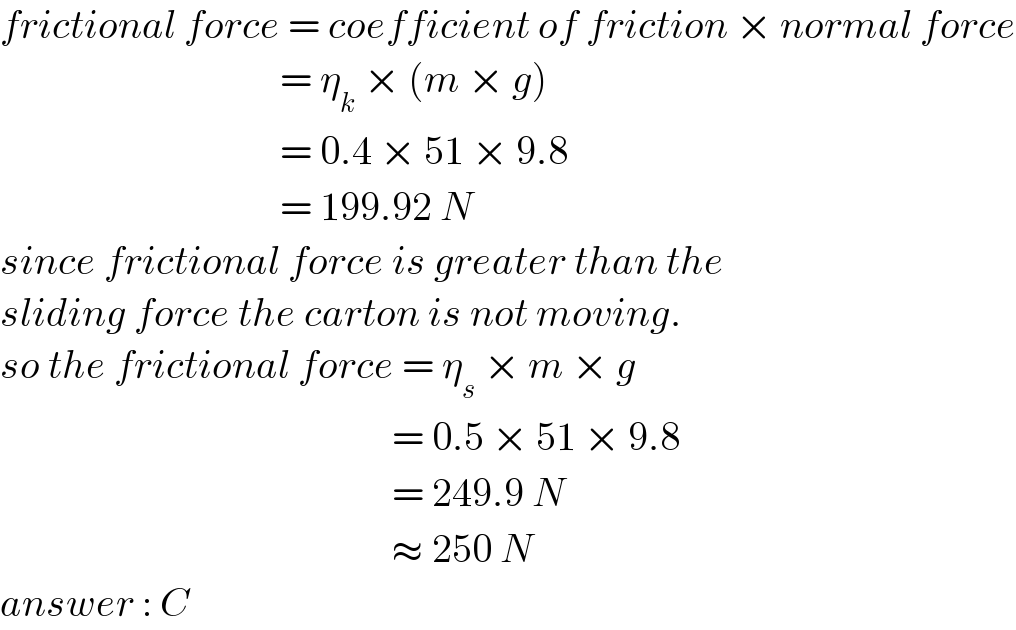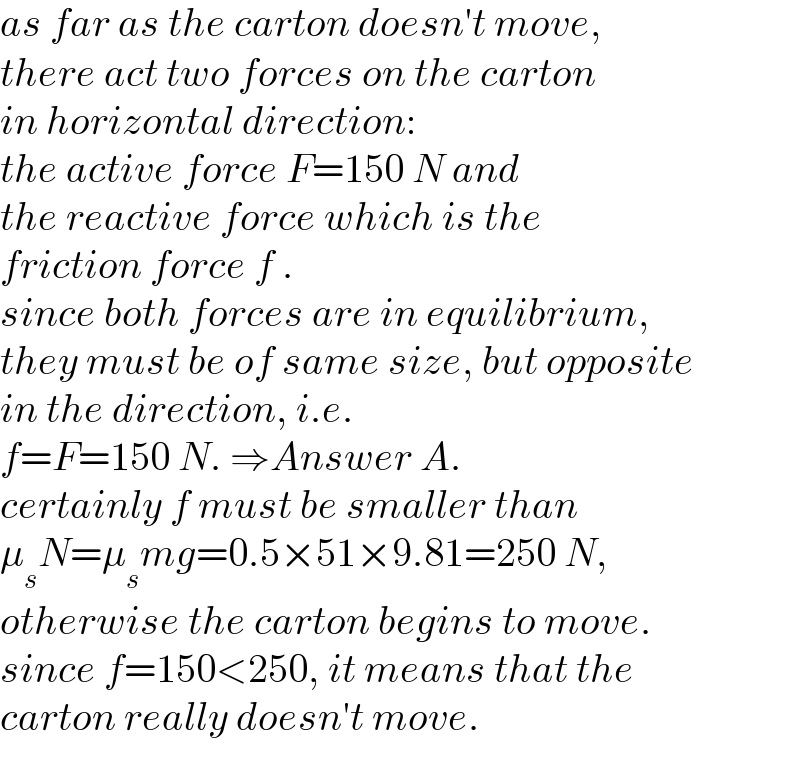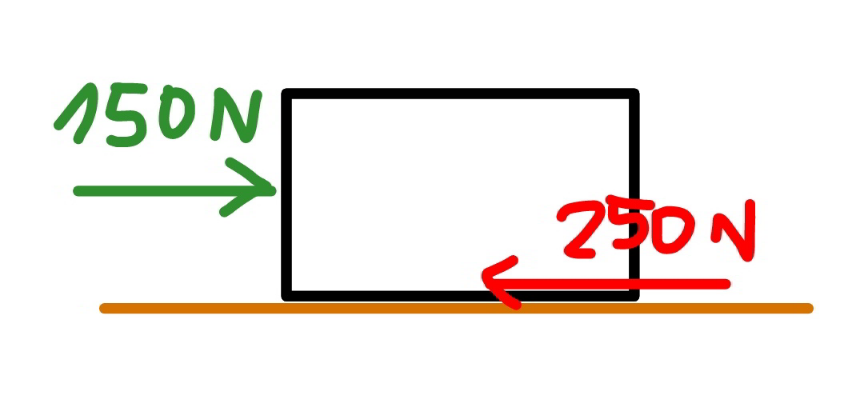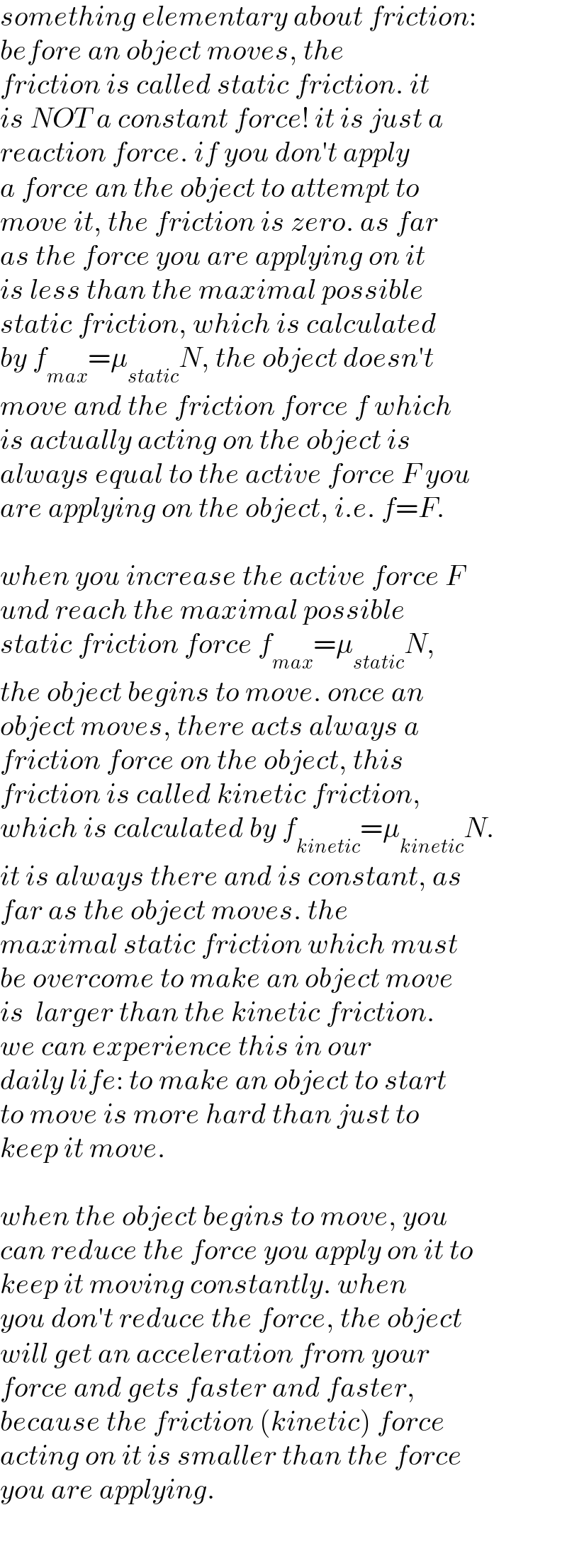Question Number 169658 by Tawa11 last updated on 05/May/22

Commented by mr W last updated on 05/May/22

$${frictional}\:{force}={active}\:{force}\:{applied} \\ $$$${on}\:{carton} \\ $$$$\Rightarrow{frictional}\:{force}\:=\mathrm{150}\:{N} \\ $$$${Answer}\:{A}\:{is}\:{correct}. \\ $$
Commented by Tawa11 last updated on 05/May/22

$$\mathrm{Ohh},\:\mathrm{God}\:\mathrm{bless}\:\mathrm{you}\:\mathrm{sir}. \\ $$
Answered by kapoorshah last updated on 06/May/22

$${frictional}\:{force}\:=\:{coefficient}\:{of}\:{friction}\:×\:{normal}\:{force} \\ $$$$\:\:\:\:\:\:\:\:\:\:\:\:\:\:\:\:\:\:\:\:\:\:\:\:\:\:\:\:\:\:\:\:\:\:\:=\:\eta_{{k}} \:×\:\left({m}\:×\:{g}\right) \\ $$$$\:\:\:\:\:\:\:\:\:\:\:\:\:\:\:\:\:\:\:\:\:\:\:\:\:\:\:\:\:\:\:\:\:\:\:=\:\mathrm{0}.\mathrm{4}\:×\:\mathrm{51}\:×\:\mathrm{9}.\mathrm{8} \\ $$$$\:\:\:\:\:\:\:\:\:\:\:\:\:\:\:\:\:\:\:\:\:\:\:\:\:\:\:\:\:\:\:\:\:\:\:=\:\mathrm{199}.\mathrm{92}\:{N} \\ $$$${since}\:{frictional}\:{force}\:{is}\:{greater}\:{than}\:{the} \\ $$$${sliding}\:{force}\:{the}\:{carton}\:{is}\:{not}\:{moving}.\: \\ $$$${so}\:{the}\:{frictional}\:{force}\:=\:\eta_{{s}} \:×\:{m}\:×\:{g} \\ $$$$\:\:\:\:\:\:\:\:\:\:\:\:\:\:\:\:\:\:\:\:\:\:\:\:\:\:\:\:\:\:\:\:\:\:\:\:\:\:\:\:\:\:\:\:\:\:\:\:\:=\:\mathrm{0}.\mathrm{5}\:×\:\mathrm{51}\:×\:\mathrm{9}.\mathrm{8} \\ $$$$\:\:\:\:\:\:\:\:\:\:\:\:\:\:\:\:\:\:\:\:\:\:\:\:\:\:\:\:\:\:\:\:\:\:\:\:\:\:\:\:\:\:\:\:\:\:\:\:\:=\:\mathrm{249}.\mathrm{9}\:{N} \\ $$$$\:\:\:\:\:\:\:\:\:\:\:\:\:\:\:\:\:\:\:\:\:\:\:\:\:\:\:\:\:\:\:\:\:\:\:\:\:\:\:\:\:\:\:\:\:\:\:\:\:\approx\:\mathrm{250}\:{N} \\ $$$${answer}\::\:{C} \\ $$
Commented by mr W last updated on 06/May/22

$${as}\:{far}\:{as}\:{the}\:{carton}\:{doesn}'{t}\:{move}, \\ $$$${there}\:{act}\:{two}\:{forces}\:{on}\:{the}\:{carton} \\ $$$${in}\:{horizontal}\:{direction}: \\ $$$${the}\:{active}\:{force}\:{F}=\mathrm{150}\:{N}\:{and} \\ $$$${the}\:{reactive}\:{force}\:{which}\:{is}\:{the} \\ $$$${friction}\:{force}\:{f}\:.\: \\ $$$${since}\:{both}\:{forces}\:{are}\:{in}\:{equilibrium},\: \\ $$$${they}\:{must}\:{be}\:{of}\:{same}\:{size},\:{but}\:{opposite}\: \\ $$$${in}\:{the}\:{direction},\:{i}.{e}. \\ $$$${f}={F}=\mathrm{150}\:{N}.\:\Rightarrow{Answer}\:{A}. \\ $$$${certainly}\:{f}\:{must}\:{be}\:{smaller}\:{than} \\ $$$$\mu_{{s}} {N}=\mu_{{s}} {mg}=\mathrm{0}.\mathrm{5}×\mathrm{51}×\mathrm{9}.\mathrm{81}=\mathrm{250}\:{N}, \\ $$$${otherwise}\:{the}\:{carton}\:{begins}\:{to}\:{move}. \\ $$$${since}\:{f}=\mathrm{150}<\mathrm{250},\:{it}\:{means}\:{that}\:{the} \\ $$$${carton}\:{really}\:{doesn}'{t}\:{move}. \\ $$
Commented by kapoorshah last updated on 06/May/22

$${the}\:{answer}\:{is}\:{C} \\ $$
Commented by mr W last updated on 06/May/22

$${then}\:{you}\:{should}\:{explain}\:{how}\:{the} \\ $$$${following}\:{is}\:{true}: \\ $$
Commented by mr W last updated on 06/May/22

Commented by Tawa11 last updated on 06/May/22

$$\mathrm{Sir}\:\mathrm{mrW}.\:\mathrm{I}\:\mathrm{understand}\:\mathrm{your}\:\mathrm{solution}\:\mathrm{since}\:\mathrm{the}\:\mathrm{time}\:\mathrm{you}\:\mathrm{solved}\:\mathrm{it}. \\ $$$$\mathrm{The}\:\mathrm{carton}\:\mathrm{does}\:\mathrm{not}\:\mathrm{move},\:\mathrm{then}\:\:\:\mathrm{f}\:\:=\:\:\mathrm{f}_{\mathrm{r}} \:\:\:=\:\:\:\mathrm{150N}. \\ $$$$\mathrm{God}\:\mathrm{bless}\:\mathrm{you}\:\mathrm{sir}. \\ $$
Commented by Tawa11 last updated on 06/May/22
![at kapoorshah sir. Thanks for your time. I reason like you before, but am sure 250N is not correct. That was why I posted the question to the forum. And sir mrW has cleared by doubt. [Ans = 150N]](https://www.tinkutara.com/question/Q169698.png)
$$\mathrm{at}\:\mathrm{kapoorshah}\:\mathrm{sir}.\:\mathrm{Thanks}\:\mathrm{for}\:\mathrm{your}\:\mathrm{time}. \\ $$$$\mathrm{I}\:\mathrm{reason}\:\mathrm{like}\:\mathrm{you}\:\mathrm{before},\:\mathrm{but}\:\mathrm{am}\:\mathrm{sure}\:\:\mathrm{250N}\:\mathrm{is}\:\mathrm{not}\:\mathrm{correct}. \\ $$$$\mathrm{That}\:\mathrm{was}\:\mathrm{why}\:\mathrm{I}\:\mathrm{posted}\:\mathrm{the}\:\mathrm{question}\:\mathrm{to}\:\mathrm{the}\:\mathrm{forum}. \\ $$$$\mathrm{And}\:\mathrm{sir}\:\:\mathrm{mrW}\:\:\mathrm{has}\:\mathrm{cleared}\:\mathrm{by}\:\mathrm{doubt}.\:\:\left[\mathrm{Ans}\:\:=\:\:\mathrm{150N}\right] \\ $$
Commented by mr W last updated on 06/May/22

$${something}\:{elementary}\:{about}\:{friction}: \\ $$$${before}\:{an}\:{object}\:{moves},\:{the} \\ $$$${friction}\:{is}\:{called}\:{static}\:{friction}.\:{it} \\ $$$${is}\:{NOT}\:{a}\:{constant}\:{force}!\:{it}\:{is}\:{just}\:{a} \\ $$$${reaction}\:{force}.\:{if}\:{you}\:{don}'{t}\:{apply} \\ $$$${a}\:{force}\:{an}\:{the}\:{object}\:{to}\:{attempt}\:{to} \\ $$$${move}\:{it},\:{the}\:{friction}\:{is}\:{zero}.\:{as}\:{far} \\ $$$${as}\:{the}\:{force}\:{you}\:{are}\:{applying}\:{on}\:{it} \\ $$$${is}\:{less}\:{than}\:{the}\:{maximal}\:{possible} \\ $$$${static}\:{friction},\:{which}\:{is}\:{calculated} \\ $$$${by}\:{f}_{{max}} =\mu_{{static}} {N},\:{the}\:{object}\:{doesn}'{t} \\ $$$${move}\:{and}\:{the}\:{friction}\:{force}\:{f}\:{which} \\ $$$${is}\:{actually}\:{acting}\:{on}\:{the}\:{object}\:{is}\: \\ $$$${always}\:{equal}\:{to}\:{the}\:{active}\:{force}\:{F}\:{you} \\ $$$${are}\:{applying}\:{on}\:{the}\:{object},\:{i}.{e}.\:{f}={F}. \\ $$$$ \\ $$$${when}\:{you}\:{increase}\:{the}\:{active}\:{force}\:{F} \\ $$$${und}\:{reach}\:{the}\:{maximal}\:{possible} \\ $$$${static}\:{friction}\:{force}\:{f}_{{max}} =\mu_{{static}} {N}, \\ $$$${the}\:{object}\:{begins}\:{to}\:{move}.\:{once}\:{an} \\ $$$${object}\:{moves},\:{there}\:{acts}\:{always}\:{a} \\ $$$${friction}\:{force}\:{on}\:{the}\:{object},\:{this} \\ $$$${friction}\:{is}\:{called}\:{kinetic}\:{friction}, \\ $$$${which}\:{is}\:{calculated}\:{by}\:{f}_{{kinetic}} =\mu_{{kinetic}} {N}. \\ $$$${it}\:{is}\:{always}\:{there}\:{and}\:{is}\:{constant},\:{as} \\ $$$${far}\:{as}\:{the}\:{object}\:{moves}.\:{the}\: \\ $$$${maximal}\:{static}\:{friction}\:{which}\:{must} \\ $$$${be}\:{overcome}\:{to}\:{make}\:{an}\:{object}\:{move} \\ $$$${is}\:\:{larger}\:{than}\:{the}\:{kinetic}\:{friction}.\: \\ $$$${we}\:{can}\:{experience}\:{this}\:{in}\:{our} \\ $$$${daily}\:{life}:\:{to}\:{make}\:{an}\:{object}\:{to}\:{start} \\ $$$${to}\:{move}\:{is}\:{more}\:{hard}\:{than}\:{just}\:{to} \\ $$$${keep}\:{it}\:{move}. \\ $$$$ \\ $$$${when}\:{the}\:{object}\:{begins}\:{to}\:{move},\:{you} \\ $$$${can}\:{reduce}\:{the}\:{force}\:{you}\:{apply}\:{on}\:{it}\:{to} \\ $$$${keep}\:{it}\:{moving}\:{constantly}.\:{when} \\ $$$${you}\:{don}'{t}\:{reduce}\:{the}\:{force},\:{the}\:{object} \\ $$$${will}\:{get}\:{an}\:{acceleration}\:{from}\:{your} \\ $$$${force}\:{and}\:{gets}\:{faster}\:{and}\:{faster}, \\ $$$${because}\:{the}\:{friction}\:\left({kinetic}\right)\:{force} \\ $$$${acting}\:{on}\:{it}\:{is}\:{smaller}\:{than}\:{the}\:{force} \\ $$$${you}\:{are}\:{applying}. \\ $$
Commented by Tawa11 last updated on 06/May/22

$$\mathrm{God}\:\mathrm{bless}\:\mathrm{you}\:\mathrm{sir}.\:\mathrm{I}\:\mathrm{really}\:\mathrm{appreciate}\:\mathrm{your}\:\mathrm{time}. \\ $$
